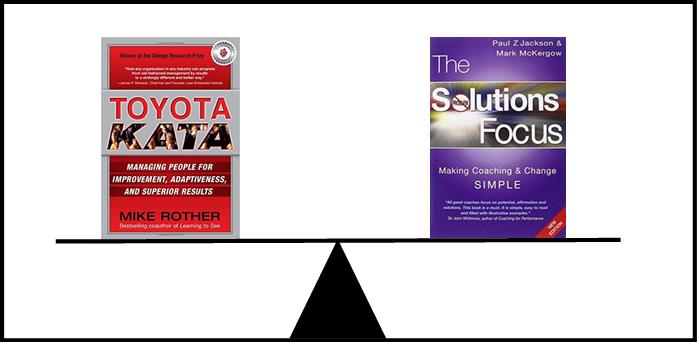IDEO seemingly popularized the Design Thinking or the Solution-Focused type approach in businesses. It dates back much further than that to numerous people like Robert McKim, Nigel Cross and a host of others. A solution-focused approach has always been something that I have used especially in the design thinking approach when applying. EDCA (Explore-Do-Check-Act). In a recent book that I read, The Solutions Focus: Making Coaching and Change SIMPLE by Paul Z Jackson and Mark McKergow I found their approach very comparable to the Toyota Kata: Managing People for Improvement, Adaptiveness and Superior Results by Mike Rother. And after reflecting on it a moment, I decided that maybe I may not have considered Toyota Kata as a Solution Focused approach. When we look at the steps of Kata and how we formulate the actual condition and select a target vision (solution) and we start iterating (PDCA) towards the vision. It fits the definition of a solution-focused approach.
Back to the work of Jackson and McKergow, they outline their methods based on not an Actual Condition but rather what they would call their Platform defined as a sensible beginning point and a point of departure in search for what works and to support additional changes. They call the Kata Version of Target Condition as Future Perfect. Defining that outcome as a spectacular leap of the imagination and the situation where the problem no longer exists. In lieu of PDCA cycles, they discuss Counters so they can measure and identify differences along the way or along the scale. Counters will accumulate additionals resources, skills, know-how, and expertise that will “count” in getting us toward the Future Perfect State. Their approach is summarized in this statement:
A Solutions Focus cycle pivots around small actions that the participants take to help the world to move with them. It is often astonishing how small a well-chosen action can be and still make a big difference.
They also add:
Any progress is a further counter toward a solution and allows a fresh visit into further affirmations and choices of the next small steps.
Their approach, of course, is not unlike or a better definition of Toyota Kata, but it adds a deepening context to the subject. More importantly, the book does an excellent job of keeping the concept simple even adding a SIMPLE acronym to the process:
SOLUTIONS NOT PROBLEMS
In between—the action is in the interaction
Make use of what’s there
Possibilities—past, present, and future
Language—simply said
Every case is different
Halfway through the book, they take a similar approach to the Toyota Kata switching gears and getting away from the tools and moving into the coaching side where you will see familiar terms like OSKAR an acronym, standing for Outcome, Scaling, Know-how, Affirm and action, Review.
I enjoy getting similar but different perspectives on subjects like this. I find it deepens my understanding and provides me a refresher. Applying slightly different techniques allows me to take better ownership and mastery of a subject. Sort of like a golfer developing their golf swing. How do you continuously practice?

